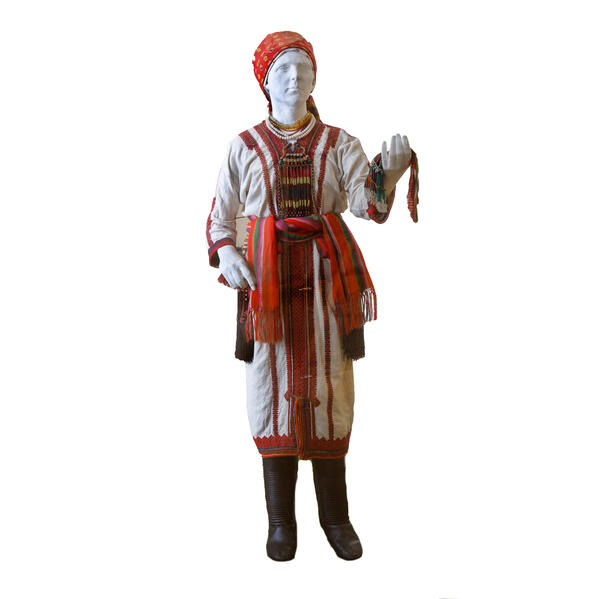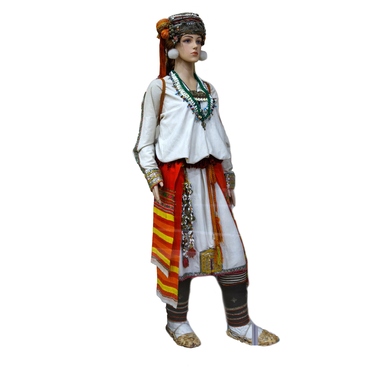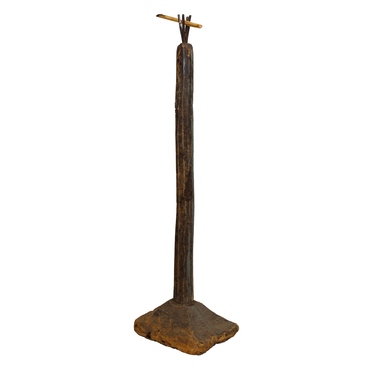The eastern group of Mordvin-Earzya lives on the territory of the Ardatovsky, Atiashevsky, Boleshebereznikovsky, Dubensky, Kochkurovsky, Chamzinsky districts of Mordovia, in the adjacent districts of the Ulyanovsk region, and in the Alatyrsky and Ibresinsky districts of Chuvashia. These lands are covered with dense deciduous mixed forests, which alternate with open spaces. In the east they are bounded by a natural boundary — the river Sura.
The important element of the local costume in the olden days was an ornament called “pulai” It was worn on the hips. In this region, the pulai was particularly opulent in shape, highlighting the hips according to the standards of female beauty. Both the pulai and the shirt worn with a slight overlap and richly decorated apron increased the volume of the figure. At the same time the girl did not seem massive and stumpy thanks to her high headdress and clear vertical stripes of décor of all clothing elements.
The main element of the costume was the shirt “panar”. It was sewn from unbleached hemp canvas. The cut of the shirt, as with all Finno-Ugric peoples, was tunic-like. Its upper part consisted of two sewn cloths, folded in half. In the center, along the seam, two cuts were made. One deep, triangular — for the head and the other — at the hem, necessary when walking. Straight sleeves without gussets were equal to the width of the canvas and fell just below the elbow. Square gussets were sewn under them.
Depending on the purpose the shirt was decorated with embroidery. It was made with woolen self-spun thread, dyed with vegetable dyes, which were extracted from the root of the cinquefoil, birch buds, alder bark and various herbs. The main color of embroidered patterns was red-brown, it was supplemented with inclusions of green and yellow. Quite often the patterns were decorated with black or blue edging. The embroidery of holiday panars was decorated with sequins.
Over the shirt married women wore a garment called “rutsya”. Its coloring was dominated by red and black. In addition to the embroidery, it was decorated with braided patterned stripes, passementerie, buttons. The general decor of the rutsya was supplemented with narrow vertical patches of red calico, which were located on the back and the bottom. Rutsya was a ritual clothing. It was worn on holidays and kept as grave clothes.
From the beginning of the 20th century the costume of the Eastern group of Mordvin-Erzya underwent considerable changes. Hard headdresses were replaced by factory-made shawls. Shirts became much more modest in decoration. Labor-intensive rutsya embroidery was replaced by strips of red calico. In the Dubensky, Atiashevsky, and Chamzinsky districts young people began to wear Russian “couples”, consisting of a blouse and skirt, or “sarapanes” — dresses of bright monochrome satin. The traditional costume here had practically disappeared by the 1950s.
The important element of the local costume in the olden days was an ornament called “pulai” It was worn on the hips. In this region, the pulai was particularly opulent in shape, highlighting the hips according to the standards of female beauty. Both the pulai and the shirt worn with a slight overlap and richly decorated apron increased the volume of the figure. At the same time the girl did not seem massive and stumpy thanks to her high headdress and clear vertical stripes of décor of all clothing elements.
The main element of the costume was the shirt “panar”. It was sewn from unbleached hemp canvas. The cut of the shirt, as with all Finno-Ugric peoples, was tunic-like. Its upper part consisted of two sewn cloths, folded in half. In the center, along the seam, two cuts were made. One deep, triangular — for the head and the other — at the hem, necessary when walking. Straight sleeves without gussets were equal to the width of the canvas and fell just below the elbow. Square gussets were sewn under them.
Depending on the purpose the shirt was decorated with embroidery. It was made with woolen self-spun thread, dyed with vegetable dyes, which were extracted from the root of the cinquefoil, birch buds, alder bark and various herbs. The main color of embroidered patterns was red-brown, it was supplemented with inclusions of green and yellow. Quite often the patterns were decorated with black or blue edging. The embroidery of holiday panars was decorated with sequins.
Over the shirt married women wore a garment called “rutsya”. Its coloring was dominated by red and black. In addition to the embroidery, it was decorated with braided patterned stripes, passementerie, buttons. The general decor of the rutsya was supplemented with narrow vertical patches of red calico, which were located on the back and the bottom. Rutsya was a ritual clothing. It was worn on holidays and kept as grave clothes.
From the beginning of the 20th century the costume of the Eastern group of Mordvin-Erzya underwent considerable changes. Hard headdresses were replaced by factory-made shawls. Shirts became much more modest in decoration. Labor-intensive rutsya embroidery was replaced by strips of red calico. In the Dubensky, Atiashevsky, and Chamzinsky districts young people began to wear Russian “couples”, consisting of a blouse and skirt, or “sarapanes” — dresses of bright monochrome satin. The traditional costume here had practically disappeared by the 1950s.



